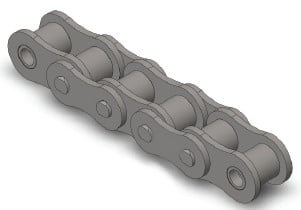The next actions should be made use of to select chain and sprocket sizes, decide the minimum center distance, and calculate the length of chain wanted in pitches. We’ll primarily use Imperial units (such as horsepower) on this part even so Kilowatt Capability tables can be found for every chain size in the preceding part. The assortment technique is the identical regardless in the units utilised.
Stage one: Ascertain the Class of the Driven Load
Estimate which on the following ideal characterizes the affliction of your drive.
Uniform: Smooth operation. Very little or no shock loading. Soft commence up. Reasonable: Normal or moderate shock loading.
Hefty: Extreme shock loading. Frequent starts and stops.
Step 2: Figure out the Services Factor
From Table one below establish the ideal Support Factor (SF) for your drive.
Step 3: Determine Style and design Electrical power Requirement
Design Horsepower (DHP) = HP x SF (Imperial Units)
or
Design Kilowatt Energy (DKW) = KW x SF (Metric Units)
The Design Power Requirement is equal on the motor (or engine) output power times the Service Component obtained from Table 1.
Phase four: Make a Tentative Chain Assortment
Make a tentative variety of the required chain dimension in the following manner:
1. If employing Kilowatt energy – fi rst convert to horsepower for this phase by multiplying the motor Kilowatt rating by 1.340 . . . This is certainly needed because the speedy selector chart is shown in horsepower.
2. Locate the Style and design Horsepower calculated in stage three by reading up the single, double, triple or quad chain columns. Draw a horizontal line through this worth.
three. Locate the rpm in the smaller sprocket over the horizontal axis  of the chart. Draw a vertical line by this value.
of the chart. Draw a vertical line by this value.
four. The intersection on the two lines need to indicate the tentative chain variety.
Step 5: Choose the quantity of Teeth for the Little Sprocket
When a tentative collection of the chain dimension is produced we have to figure out the minimum amount of teeth necessary within the compact sprocket necessary to transmit the Design and style Horsepower (DHP) or even the Layout Kilowatt Energy (DKW).
Stage 6: Determine the amount of Teeth for that Large Sprocket
Make use of the following to determine the amount of teeth for the huge sprocket:
N = (r / R) x n
The quantity of teeth within the massive sprocket equals the rpm in the compact sprocket (r) divided from the sought after rpm on the significant sprocket (R) instances the quantity of teeth on the tiny sprocket. If your sprocket is also significant for the area obtainable then multiple strand chains of a smaller sized pitch really should be checked.
Step 7: Determine the Minimal Shaft Center Distance
Make use of the following to determine the minimal shaft center distance (in chain pitches):
C (min) = (2N + n) / six
The above can be a guidebook only.
Step eight: Examine the Ultimate Variety
Also bear in mind of any probable interference or other area limitations that may exist and adjust the assortment accordingly. Normally quite possibly the most efficient/cost eff ective drive makes use of single strand chains. That is mainly because multiple strand sprockets are additional high priced and as could be ascertained from the multi-strand things the chains become much less effi cient in transmitting electrical power as the amount of strands increases. It really is thus frequently finest to specify single strand chains each time attainable
Phase 9: Identify the Length of Chain in Pitches
Use the following to determine the length from the chain (L) in pitches:
L = ((N + n) / 2) + (2C) + (K / C)
Values for “K” might be identified in Table four on webpage 43. Keep in mind that
C will be the shaft center distance offered in pitches of chain (not inches or millimeters and so forth). In the event the shaft center distance is known inside a unit of length the worth C is obtained by dividing the chain pitch (in the identical unit) from the shaft centers.
C = Shaft Centers (inches) / Chain Pitch (inches)
or
C = Shaft Centers (millimeters) / Chain Pitch (millimeters)
Note that every time possible it is actually most effective to employ an even number of pitches so as to keep away from using an off set link. Off sets never possess the identical load carrying capability since the base chain and should really be prevented if feasible.